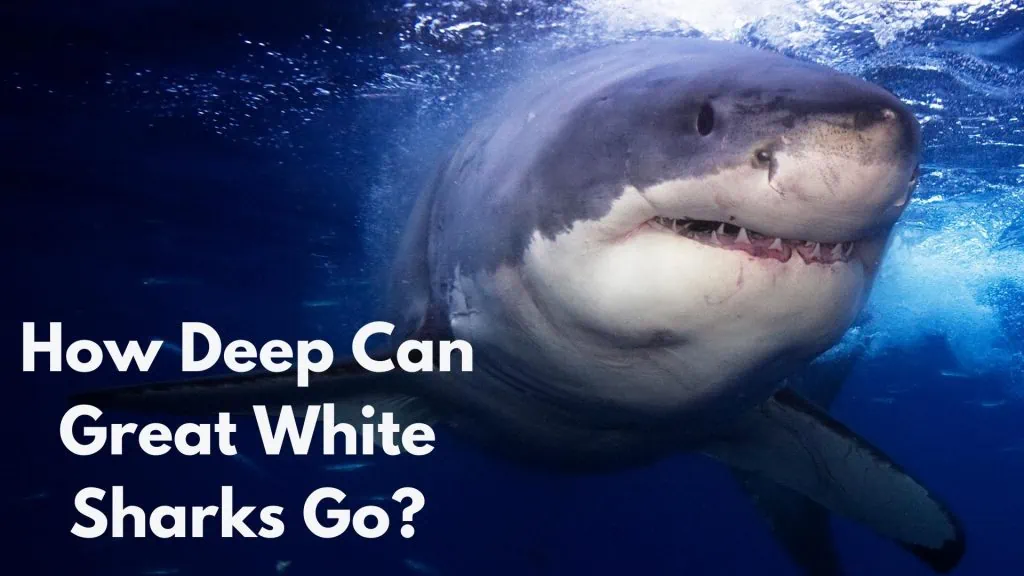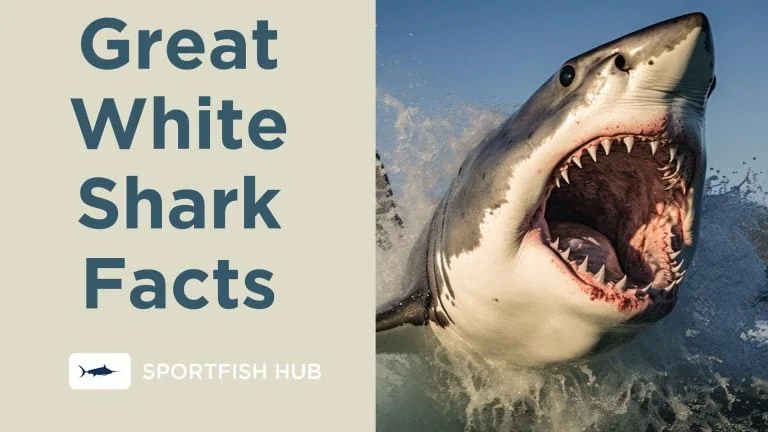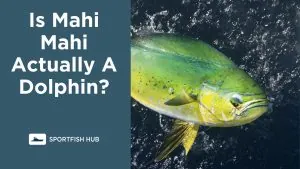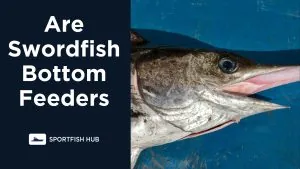The great white shark (Carcharodon carcharias) is one of the most iconic and feared predators in the ocean. As the largest predatory fish on Earth, great whites inspire awe and fascination along with fear. Read on to learn amazing facts about these incredible hunters of the deep.
Table of Contents
- Great White Shark Facts
- How fast can a great white swim?
- How Deep Can Great White Sharks Go?
- How many teeth does a Great White Shark have?
- Hunting Behavior and Prey
- Breeding and Lifecycle
- Distribution and Habitat
- Conservation Status- Why Great White Sharks Are Endangered
- FAQ
- Do great white sharks attack humans?
- Why do great whites migrate long distances?
- How do great white sharks give birth?
- How many rows of teeth do great white sharks have?
- Conclusion
Great White Shark Facts
- Scientific name: Carcharodon carcharias
- Average adult size: 4-6 meters (13-20 feet) long; weighing 680-1,800 kg (1,500-4,000 lbs)
- Lifespan: Estimated up to 70 years or more
- Habitat: Cool, coastal waters worldwide; often near seals and sea lions
- Unique adaptations:
- Streamlined, torpedo-shaped body for fast swimming
- Ability to maintain body heat warmer than surrounding water
- Specialized senses for hunting (vision, smell, electroreception)
- Serrated, triangular teeth ideal for grasping slippery prey
- Jaws that can detach further to allow extra gape
- Liver that has high oil content to provide buoyancy
How fast can a great white swim?
The top speed of a great white shark is about 25 mph (40 kph) with short bursts of speed around 35 mph (56 kph). Their average cruising speed is between 3-5 mph (5-8 km/h), but they can reach speeds of up to 12 mph (19 km/h) when needed.

How Deep Can Great White Sharks Go?
The deepest a shark has gone while being studied was a shark called “Shack,” that was recorded swimming at a depth of 3,937 feet. This is still an unusual depth for Great White Sharks to swim, considering that most of their typical prey is found at much more shallow depths.
How many teeth does a Great White Shark have?
The great white shark has a conveyor belt-like system of teeth replacement. At any given time, there are around 50 exposed teeth in the shark’s mouth – up to 28 teeth in the upper jaw and up to 25 in the lower.
However, behind this exposed set of chompers lies multiple rows of replacement teeth just waiting to move forward. In total, a great white shark can have over 300 teeth in their jaws at various stages of development. This tooth factory allows them to lose and replace over 20,000 teeth over their lifetime!
See also: 16 Myths About Sharks Debunked.
These powerful swimmers migrate long distances and have been recorded diving to depths of 1,200 meters. Though they often live in cooler waters, great whites are warm-blooded and can maintain a body temperature that is up to 14°F warmer than the surrounding water.
Great White Shark Senses
| Sense | Description |
|---|---|
| Vision | Excellent vision helps them detect prey movements and silhouettes from a distance. Wide pupils provide good vision in both bright and dim light. |
| Smell | Good directional hearing picks up low-frequency vibrations from struggling prey. |
| Hearing | Pores on the snout called the ampullae of Lorenzini detect electric fields from prey’s muscle movements and heartbeats. |
| Electroreception | Pores on snout called the ampullae of Lorenzini detect electric fields from prey’s muscle movements and heartbeats. |
Their sense of smell is so strong that they can detect just a few drops of blood in tens of liters of water. Electroreceptors along their snouts allow them to hone in on the electric fields generated by prey. Their serrated teeth provide a firm grip when biting into slippery sea lions or seals.
Hunting Behavior and Prey
Great white sharks are carnivorous hunters whose diet consists primarily of fish, seals, sea lions, small toothed whales, sea turtles, sea otters, and carrion (dead animals). They are ambush predators that rely on stealth and surprise to catch unaware prey. Their typical hunting strategy is:
- Detect prey using electroreception and keen senses of vision and smell
- Approach with a fast, powerful burst of speed while prey’s back is turned
- Hit with tremendous force to stun and injure prey
- Retreat and wait for weakened prey to die or succumb to blood loss
- Return and eat prey at leisure once it is dead or incapacitated
Young great white sharks eat mostly fish while adults tend to hunt marine mammals like seals, sea lions, and small whales. But these opportunistic predators aren’t very picky and will eat just about any animal protein they come across.
Breeding and Lifecycle
Very little is known about great white reproduction because it is rarely observed. Here are some key points:
- Females are thought to reach maturity at 12-14 years; males at 9-10 years
- Mating occurs in the winter or spring in offshore waters
- Gestation may last over a year before giving birth to up to 14 pups
- Young sharks are already 4-5 feet long at birth
- It takes about 10-15 years for juveniles to fully mature
Females return to the same offshore birthing site every two to three years. They may swim more than a thousand miles to reach these locations.
You might also enjoy reading: What Eats Sharks?
Young sharks spend the first years of life in coastal nursery areas abundant in food. As juveniles, they are already formidable hunters, eating mostly fish and rays. Those that survive the high mortality rates of the early years can live for decades, perhaps as long as 70 years.
Distribution and Habitat
Great whites are found in all major oceans from latitudes of 60°N to 60°S. In the western Atlantic, they live from Newfoundland to the Gulf of Mexico and south to Brazil. Populations also occur around most island groups in the Pacific and Indian Oceans.
These sharks prefer coastal, temperate seas with water temperatures from 12-24°C. They seldom enter tropical waters. Though they range far out to sea as adults, great whites often frequent shallow shoreline areas and rarely venture into waters deeper than 1,000 meters.
Key great white territories include:
- Northern and Central California, especially the Farallon Islands
- Guadalupe Island off Baja California
- Southern Australia and South Africa
- Mediterranean Sea
- Japan and the Korean Peninsula
Conservation Status- Why Great White Sharks Are Endangered
The great white shark is classified as vulnerable by the IUCN Red List. Their numbers are declining primarily due to accidental bycatch in commercial fishing gear, sport fishing harvest, entanglement in marine debris, persecution by beach protection programs, and the demand for jaws and fins in the shark fin trade.
Great White Population Estimates by Region:
| Region | Estimated Population | Conservation Status |
|---|---|---|
| Northeast Pacific | 2,400 | Lower Risk/Conservation Dependent |
| Northwest Atlantic | Over 5,000 | Lower Risk/Near Threatened |
| South Africa | Unknown, several thousand | Vulnerable |
| Australia | Less than 5,000 | Vulnerable |
| Mediterranean | Possibly fewer than 1,000 | Regionally Critically Endangered |
However, they are now protected in many areas worldwide such as Australia, the US Atlantic and California, the Mediterranean, and South Africa. Better protection and sustainable fishing practices are critical for the future of this iconic ocean predator.
Great whites play an important role as apex predators in marine ecosystems. As predators near the top of the food chain, they help regulate prey populations and weed out sick or injured animals. Protecting top predators is vital for maintaining diversity and balance in ocean life.
FAQ
-
Do great white sharks attack humans?
Great whites are not mindless man-eaters. They sometimes bite humans out of curiosity or mistake them for prey. But attacks are very rare – far less than 100 worldwide per year. You are much more likely to be killed by dogs, bees, or lightning than by a shark.
-
Why do great whites migrate long distances?
They migrate to take advantage of seasonal feeding and breeding opportunities. Northern great whites move south in winter to enjoy warmer waters and abundance of prey. They return north in summer to take advantage of seal pupping season for plentiful food.
-
How do great white sharks give birth?
Very little is known about great white reproduction. It is believed they give live birth to litters of up to 14 pups after a gestation of over one year. The mother shark then leaves her offspring to fend for themselves.
-
How many rows of teeth do great white sharks have?
Great white sharks typically have five rows of teeth in each jaw, with up to 28 exposed teeth in the upper jaw and up to 25 in the lower jaw.
Conclusion
In summary, the powerful great white shark remains an awe-inspiring force of nature. Learning more about their biology and life history is key to ensuring their survival in the changing oceans of the future. With greater understanding and protection, these icons of the deep can continue their reign as rulers of the sea.












